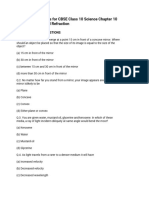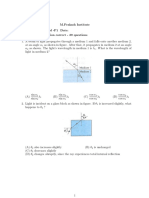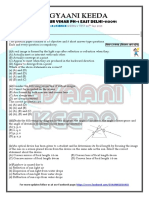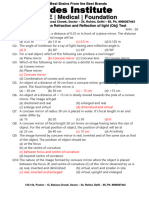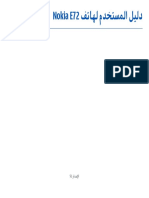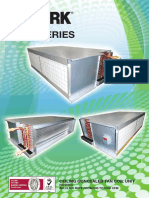RYAN INTERNATIONAL SCHOOL, VASANT KUNJ
Physics Assignment-3
Time : 3 Days
Q1. Assertion: A convex lens maybe diverging
Reason: The nature of lens depends upon refractive index of the lens and surrounding
medium.a) Both A and R are true, and R is the correct explanation for A.
b) Both A and R are true, and R is not the correct explanation for A.
c)A is true but R is false.
d)A is false and R is false
Q2. Assertion: If a convex lens is kept in water, its convergence power decreases.
Reason: The refractive Index of convex lens relative to water is less than that relative to air.
a) Both A and R are true, and R is the correct explanation for A.
b) Both A and R are true, and R is not the correct explanation for A.
c)A is true but R is false.
d)A is False but R is true.
Q3. Assertion: Propagation of light through an optical fiber is due to total internal reflection
taking place
at the core-clade interface.
Reason: Refractive index of the material of the core of the optical fiber is greater than that of
cladding.
a) Both A and R are true, and R is the correct explanation for A.
b) Both A and R are true, R is not the correct explanation for A.
c)A is true but R is false.
d)A is False but R is true.
Q4. Two thin lenses of focal lengths 20 cm and 25 cm are placed in contact. The effective
power of the
combination is:
(A) 45 D
(B) 9 D
(C) 19 D
(D) 6 D
Q5. The air bubble inside water shine due to
(A) Reflection
(B) Refraction
(C) Total internal reflection
(D) None of these
Q6. A glass lens is immersed in water. What will be the effect on the power of lens?
(A) increase
(B) decrease
(C) constant
(D) not depends
�Q7. A real, inverted and equal in size image is formed by
(A) a concave mirror
(B) a convex mirror
(C) a plane mirror
(D) none of these
Q8. When light is refracted into a medium,
(A) its wavelength and frequency both increase
(B) its wavelength increases but frequency remains unchanged
(C) its wavelength decreases but frequency remains unchanged
(D) its wavelength and frequency both decrease
Q9. The refractive indices (R.I.) of glass and water with respect to air are 3/2 and 4/3
respectively. The
R.I. of glass with respect. to water is:
(A) 8/9
(B) 9/8
(C) 7/6
(D) 2
Q10. A convergent lens will become less convergent in
(A) Oil
(B) water
(C) both of (i) and (ii)
(D) none of these
Q11. When a beam of light is incident on a plane mirror, it is found that a real image is
formed. The incident beam must be
(A) Converging
(B) Diverging
(C) Parallel
(D) Formation of real image by a plane mirror is impossible
Q12. A person 1.6 m tall is standing at the centre between two walls three metre high. What
is the minimum size of a plane mirror fixed on the wall in front of him, if he is to see the full
height of
the wall behind him?
(A) 0.8 m
(B) 1 m
(C) 1.5 m
(D) 2.3 m
Q13. A man stands in front of a mirror of special shape. He finds that his image has a very
small head, a
fat body, and legs of normal size. What can we say about the shapes of the three parts of the
mirror?
(A) Convex, Concave, Plane
(B) The plane, Concave, Convex
(C) Concave, Convex, Plane
(D) Convex, Plane, Concave
�Q14. Figure shows 2 rays A and B being reflected by a mirror and going as A’ and B’, the
mirror is
(a) Plane
(b) convex
(c) concave
(d) may be any spherical mirror
Q15. A thin lens is made with a material having refractive index (µ=1.5). Both the sides are
convex ,It is
dipped in water it will behave like
(a) Convergent lens
(b) Divergent lens
(c) Rectangular slab
(d) Prism
Q16. A convex mirror have focal length ‘f’ produces an image n times the size of the object.
If the image is
real then the distance of object from mirror is
(a) (n-1)f
(b)(n+1)f
(c) (n+1/n)f
(d) (n-1/n)f
Q17. The refractive index of the material of a prism is √2 and its refracting angle is 30°,one
of the
refracting surface of the prism is made a mirror. A beam of monochromatic light entering the
prism
from the other face retraces its path after reflection from mirror surface. The angle of
incidence on
prism is
(a) 0°
(b) 30°
(c) 45°
(d) 60°
Q18. For a chromatic combination of lenses if we use two lenses of focal length f° and f0,
dispersive power
to w and w’ respectively then
(a) w=w0 ,w’= 2w0 f’= 2f
(b) w=w0 ,w’= 2w0 f’= -2f
(c) w=w0 ,w’= 2w0 f’= f/2
(d) w=w0 ,w’= 2w0 f’= -f/2
Q19. A fish is little away below the surface of a table if the critical angle is 49°,the fish could
see some
things above the water surface within an angle of Ꝋ°,where
�(a) Ꝋ= 49°
(b) Ꝋ= 98°
(c) Ꝋ= 90°
(d) Ꝋ= 24.5°
Q20. A V-shaped wire is placed before a concave mirror having radius of curvature 20cm as
shown in fig,the total length of the image
(a) 30cm
(b) 40cm
(c) 10cm
(d) 20cm
Q21. ASSERTION - A diamond of refractive index √6 is immersed in a liquid of refractive
index of √3, If
light travels from diamond to liquid. Total internal reflection takes place when angle of
incidence is
30°
REASON - µ=1/sinC, where µ is the refractive index of diamond with respect to liquid.
Q22. ASSERTION – If a plane glass slab is placed on the letters of different colors,all the
letters appear to
be raised to the same height.
REASON - Different colors have different wavelength
Q23. ASSERTION – Although the surface of goggles lens curved it does not have any power
REASON - In case of goggles both the curved surface have equal radius of curvature






























